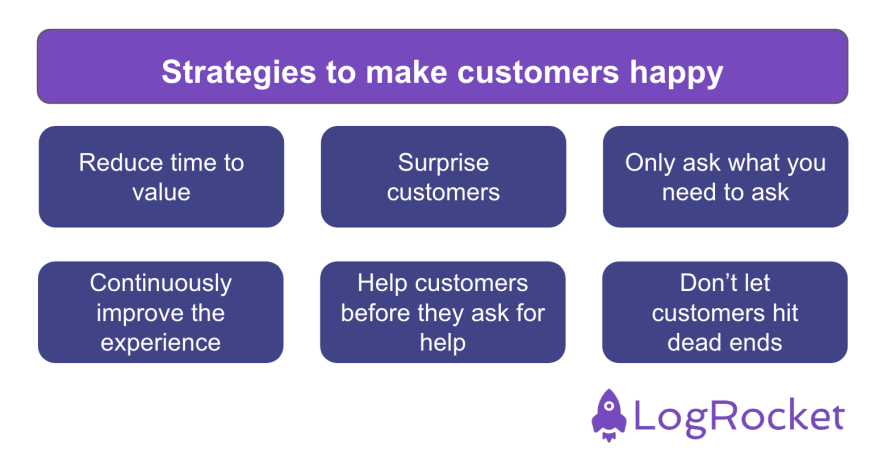Sometimes, I think we complicate the business world.

First things first — businesses exist to make people’s lives better. The rest will follow when your product or service helps customers achieve what they want.
Happy customers return value to the business and enable growth. Unhappy customers go to your competitors and bring their friends with them.
Often, I fear that companies start with the business and then try to figure out how to deliver value to customers. That rarely works. That’s why starting with the customer and figuring out how to collect business value is important. Yet, I’m not suggesting you do whatever customers want. You need to have a value exchange between both sides. Otherwise, the business will fail.
Now, let me tell you one important thing: acquiring customers is one thing, but keeping them satisfied is another. Let’s talk about it.
Customers expect high-quality service today. Unlike a few decades ago, customers have plenty of alternatives to get a job done, so you must provide outstanding service to make them happy.
A customer will become a happy one when three things happen:
If you fail to deliver in one of the above, you have a high chance of having detractors.
Customers hire you to do something for them. If they like how you do it, they will come back. Yet, they will never return if you fail to deliver on their expectations.
A common challenge is that what worked yesterday may not work tomorrow. Let me take an example of Medium.com for bloggers.
As a blogger, I used Medium for years (see here), and I was happy until they changed their distribution algorithm. Despite having more than 91,000 followers, I struggled to reach them. I could barely get that many readers per month.
So what did I do? I moved to Medium’s competitor, Substack, because I became dissatisfied with Medium’s service. Consequently, many of my followers canceled their subscriptions and followed me there.
That’s just an anecdote but the moral of the story is when a business fails to satisfy customers, they have no chance but to search for alternatives.
Understanding your customers is fundamental. That’s why it’s essential to categorize them. I like using the Net Promoter Score (NPS) because it helps me understand which strategies to apply. There are three types of customers varying in levels of happiness: promoters, passives (neutral), and detractors.
Once you understand your level of customer satisfaction, you will understand which action to take. Let’s discuss it further.
Let’s understand some examples that drive satisfaction up:

Let’s take an online shop as an example. If customers need to sign up and inform their address and payment method before concluding a purchase, that’s too long. Some ecommerce enables guest checkouts and PayPal. That way, customers don’t sign up. Everything happens faster. The faster customers collect value, the more they are willing to return.
Do what customers need before they ask for it. For example, whenever I send a newsletter with Substack, I get a few images in my mailbox to use on social media. That’s great because I can post my content smoothly. Customers love pleasant surprises.
Ensure you don’t ask for information you don’t need. Limit to the bare minimum. I travel a lot, and I notice that hotels ask for unnecessary information. Despite having an online booking, they often ask for my birthday, address, and nationality, which brings no value to me, and I have to spend time with them.
Your competition landscape only gets stronger, and so should your product. Empathize with your customers and constantly make your experience more pleasant, natural, and intuitive for your customers. If you fail to do that, why would they remain loyal?
It might be too late if you only help them when they ask. For example, create onboarding guides, observe how long customers take to get tasks done, and, when too long, automatically offer help. When you understand how the experience should be, you can monitor it and unstuck customers before they get annoyed.
One of the most frustrating things happens when customers invest time and then receive a message they cannot proceed. Ensure customers never hit dead ends. Let me give you an example of a corporate car.
When I had to choose a car through LeasePlan, I’d select the brand, vehicle, model, accessories, color, etc. Only at the end did I receive a message that the car didn’t fit the requirements. I got annoyed as I wasted time. A better experience would be to show only vehicles I could select in the first place.
No business will survive without customers.
Let me set some points straight:
Businesses do exist to create value for multiple stakeholders beyond customers (shareholders, investors, employees, etc). Yet, where you start is very important. It’s natural to start from a business perspective and try to figure out how customers will benefit from internal ideas.
Your product or service has a higher chance of thriving when it starts by addressing customers’ needs first.
When businesses neglect customer satisfaction, they will have difficulty having loyal customers. It’s fundamental to continuously learn what customers like about your service and do more of that, understand what they dislike, and fix the experience.
You will hear often about growth, which is essential, but when to grow is even more critical. Don’t de-prioritize customer satisfaction, or results may be unbearable.
I was part of a company that was doing well, customers were satisfied, and business was growing organically. Eventually, the founders decided to expand to another country, but they did it too fast. As a result, employees had to focus on the expansion, reducing customer satisfaction because we turned attention away from customers. A year after the expansion began, our biggest trouble was customer retention. As we deprioritized them, we lost their loyalty.
First comes customer satisfaction, and then the rest follows.
So, ensure customers get what they came for (value proposition), the cost is balanced, and the experience is pleasant. Understand how satisfied your customers are and categorize them into promoters, neutrals, and detractors. This will help you take action.
You can use a number of strategies to drive customer satisfaction. Start with the customer, then determine how to create business value. Remember, no business can thrive without a high number of satisfied customers.

LogRocket identifies friction points in the user experience so you can make informed decisions about product and design changes that must happen to hit your goals.
With LogRocket, you can understand the scope of the issues affecting your product and prioritize the changes that need to be made. LogRocket simplifies workflows by allowing Engineering, Product, UX, and Design teams to work from the same data as you, eliminating any confusion about what needs to be done.
Get your teams on the same page — try LogRocket today.

Most teams fail at autonomy. Learn how clear rules help product teams move faster without micromanagement.

A practical framework for PMs to use AI in ideation without sacrificing judgment, strategy, or decision quality.

A practical five minute revenue estimation method to help product managers compare ideas, drop low impact features, and prioritize smarter.

A practical guide for PMs who want to stop being bottlenecks, delegate smarter, and lead teams effectively with a clear ownership framework.